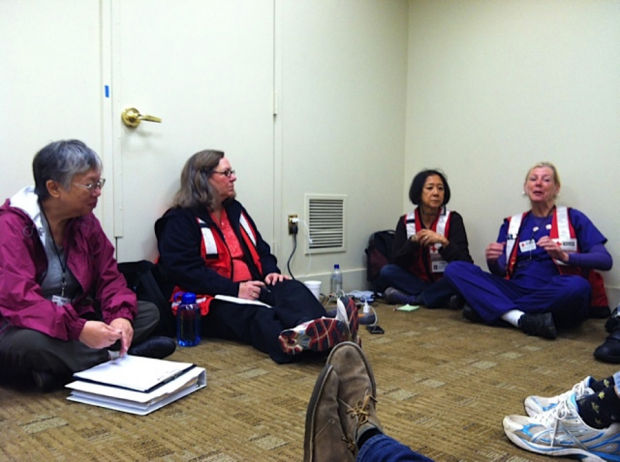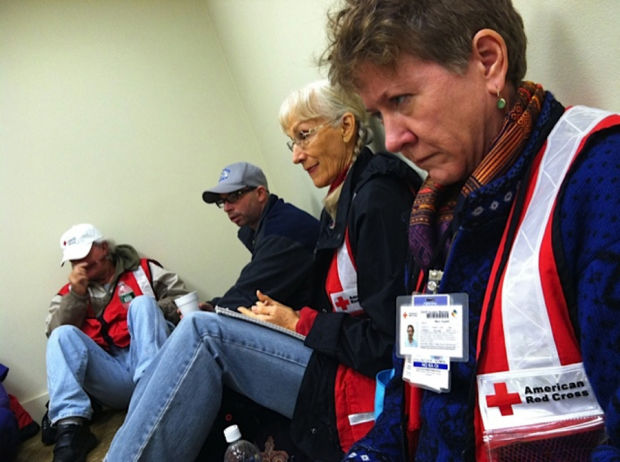HANALEI — In the aftermath of a major weather event, people often feel at a loss to know how to help survivors rebuild their lives.
Some may reach out directly to family and friends, others may send financial support to agencies and a very select few will pack their bags and head to the actual site to offer aid.
In the aftermath of Superstorm Sandy, author Lorelei Armstrong of Hanalei had the time to travel to the northeastern part of the country with the Red Cross, where she served as a shelter volunteer for nearly three weeks.
After sleeping on a freezing floor, cleaning toilets, and serving coffee in bowls, Armstrong has returned to Kaua‘i and hopes to use her experience to help others.
“Our local volunteers who deployed to assist in this large response have returned with invaluable experiences so that we are better prepared in Hawai‘i when a major disaster strikes here,” said Coralie Matayoshi, CEO for the Hawai‘i State Chapter.
Armstrong was far from alone — the Hawai‘i State Chapter of the American Red Cross continues to send local volunteers to help Sandy victims on the East Coast. This week, two more volunteers from the Big Island and two from O‘ahu will be going to New York and New Jersey this week to continue assisting the Red Cross response. 47 people in total have left Hawai‘i to help the Red Cross across the Northeast.
Long after the cameras have left, there are still people in the Northeast without the most basic of supplies. And the Red Cross is still on the ground helping as best they can.
Nearly 1,000 Red Cross workers are continuing to assist people affected by the storm with food, emotional support and longer-term assistance, according toof Red Cross. More than 16,500 have volunteered since the storm hit in October.
Have bucket, will travel
It was Armstrong’s first experience helping out off-island. In her volunteer path, Armstrong started off as a long-term blood donor here on Kaua‘i and in California. She started thinking of ways she could help. As an author, her time is her own, so she was able to schedule a three-week tour.
“I brought my own bucket,” she said. It “may look weird, (but) it was useful.”
Filled to the brim with items suggested by the Red Cross — rubber knee-length boots, chemical resistant gloves, scrubbing things, towels, warm clothes and gloves — the bucket came in really handy as they traveled to the other side of the country for their assignments.
“You can clean anything,” Armstrong said. “I can’t fix everything, but I can give them a clean facility.”
Some days, Armstrong said, she did intensive cleaning in public bathrooms up to four times a day to help people in the shelter have sanitary conditions and stay healthy during high stress situations.
She said that the Red Cross classifies trips with number of possible hardships that could come up, such as facing cold weather or dealing with a lack of food.
There were 12 on the list, and 11 came up during her three-and-a-half week trip.
“It’s hard work,” she said. “There’s always something to do when there’s nothing else to do. You’re working to provide someone with enough shelter for someone to keep living their life. People are stressed and it comes out in front of everyone.”
In the end, as they closed shelters and got people back into their lives, she worked to return the shelter to its original purpose.
“One custodian came in and said, ‘It’s cleaner than when you found it,’” Armstrong added.
Watching a shelter disappear
Armstrong equated her experience as closer to a camping trip, as volunteers often slept on cots or even on the floor. At one point, the group of folks she was serving with from Hawai‘i was relocated after norovirus broke out in a shelter. Unable to properly disinfect the cot she was given, Armstrong created a bed on the floor for the night.
She said volunteers were given wool blankets, and since shelters were often colder that she expected, she would grab several blankets and use her puffy coat as a pillow to stay warm at night.
For Armstrong though, she was used to near camping conditions. In 1996, she bought the oldest house in Princeville — it was built in 1973 — and spent 10 months sleeping on a couch as her house wasn’t rebuilt properly after Hurricane ‘Iniki and she spent months fixing up the damage to her home.
“I wondered if my house would ever be a home again,” she said.
That experience helped to have a greater appreciation of the issues and hardships being faced by the people she worked with in the shelters, and helped her to better understand how it can sometimes takes years and years to get things back in order.
Trained Red Cross workers help provide people assistance with home repairs, rent, utility deposits and connecting them with social service programs.
It was helping people get out of the shelters and back on their feet that showed Armstrong the true joy that comes from volunteerring.
She spoke of helping one woman with the process of relocating her husband to a nursing home.
“The woman was just glowing,” Armstrong said. “The shelter just disappeared. It was the loveliest thing I took away: New Yorkers are resilient.”
The shelter residents were even pitching in. She said people in the community often felt in control when they would help out around the shelter and would often look for work, whether it was supervising or just running a mop.
Ordering 5,000 servings of mustard
Armstrong said she often rotated duties and tried different jobs in the shelter, including a stint running the kitchen.
She said one day, she put in an order for 5,000 servings of mustard, while another day the kitchen ran out of cups and resorted to serving coffee in bowls.
Thanks to the public’s generous support, the Red Cross has provided food, shelter, relief supplies and comfort to tens of thousands of Sandy survivors.
On an average day, the Red Cross still has been distributing approximately 33,000 meals and snacks in New York.
Overall, the Red Cross has served more than 10.5 million meals and snacks in the aftermath of Hurricane Sandy. Red Cross volunteers are also supporting several community food banks in New York to help provide an additional 60,000 meals a day to people in the hardest hit areas.
The state of New York operates shelters during the first 96 hours of an emergency, then hands the shelter over to the Red Cross and other agencies, Armstrong said.
Overall, a range of groups provided more than 158,000 shelter stays for Sandy, and the Red Cross provided more than 81,000 of those stays.
She said the shelters also offer nursing services and mental health counseling to deal with stress, and they have provided more than 108,000 health services and emotional support contacts to those hardest hit.
Armstrong said there was one nurse from the Hawai‘i group of volunteers who coordinated with a local pharmacist to arrange dialysis for a person at the shelter.
“You’re holding people in your hands, and need to help them get the care and attention they need,” she said.
The cost of her flight was covered by the Red Cross and she was issued a debit card to help cover the cost of gas and food, so that volunteers don’t incur expenses.
Lessons learned
By the end of Armstrong’s trip, she came back home with a second bucket and a new blanket made out of old Coke bottles. She also lost her water bottle and a pair of scissors, but traveled with her most important things in her carry-on.
She encouraged people to make a written list of things to take with them in an emergency, after watching people show up at the shelter with their jewelry and jackets, only to discover that they forgot to grab their insulin.
And the Red Cross does not offer shelter for pets, so Armstrong reminded people to make sure they provide secure enclosures for their people.
She hopes more volunteers from Kaua‘i will make the time to give their time to the Red Cross, whether they respond locally or area able to travel to disaster areas.
“Even if they just take the training on how to help in an emergency and get first aid and CPR training,” she said, adding a request for financial support. “When you see the Red Cross asking for money on Kaua‘i, that money stays on Kaua‘i.”
She noted that people are asked to “shelter in place” when there is a hurricane and respond as they can, adding “If your house survived, go help others.”
Kaua‘i has 16 Public Emergency Shelters located throughout the island.
This article was reflected to show Kaua‘i has 16 Public Emergency Shelters located throughout the island.






